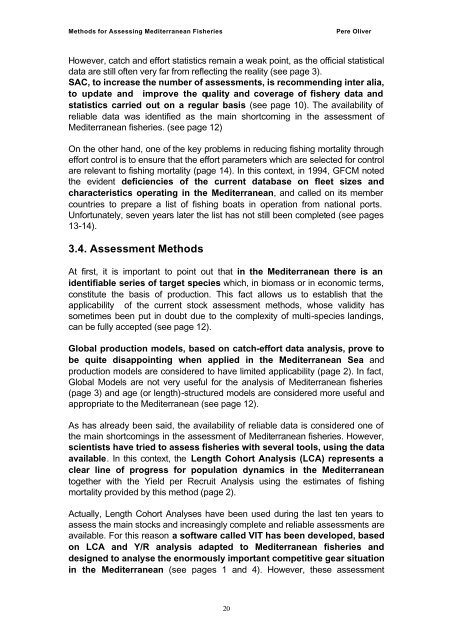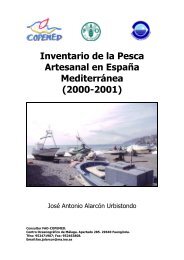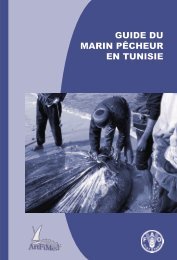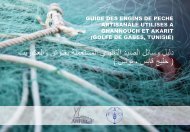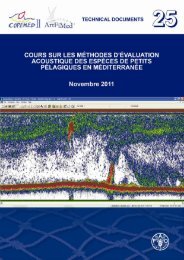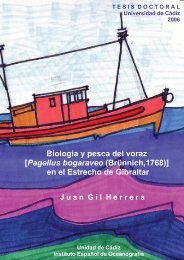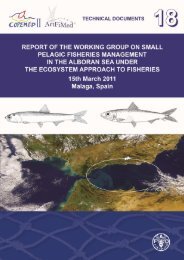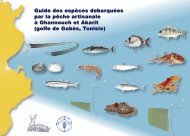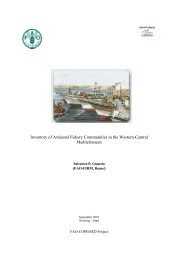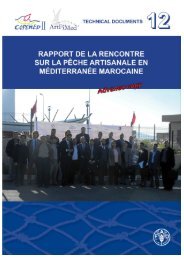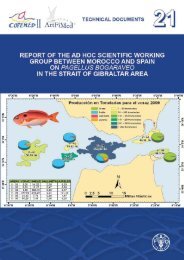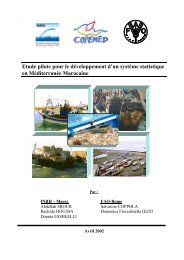Methods for Assessing Mediterranean Fisheries - Fao - Copemed
Methods for Assessing Mediterranean Fisheries - Fao - Copemed
Methods for Assessing Mediterranean Fisheries - Fao - Copemed
You also want an ePaper? Increase the reach of your titles
YUMPU automatically turns print PDFs into web optimized ePapers that Google loves.
<strong>Methods</strong> <strong>for</strong> <strong>Assessing</strong> <strong>Mediterranean</strong> <strong>Fisheries</strong><br />
Pere Oliver<br />
However, catch and ef<strong>for</strong>t statistics remain a weak point, as the official statistical<br />
data are still often very far from reflecting the reality (see page 3).<br />
SAC, to increase the number of assessments, is recommending inter alia,<br />
to update and improve the quality and coverage of fishery data and<br />
statistics carried out on a regular basis (see page 10). The availability of<br />
reliable data was identified as the main shortcoming in the assessment of<br />
<strong>Mediterranean</strong> fisheries. (see page 12)<br />
On the other hand, one of the key problems in reducing fishing mortality through<br />
ef<strong>for</strong>t control is to ensure that the ef<strong>for</strong>t parameters which are selected <strong>for</strong> control<br />
are relevant to fishing mortality (page 14). In this context, in 1994, GFCM noted<br />
the evident deficiencies of the current database on fleet sizes and<br />
characteristics operating in the <strong>Mediterranean</strong>, and called on its member<br />
countries to prepare a list of fishing boats in operation from national ports.<br />
Un<strong>for</strong>tunately, seven years later the list has not still been completed (see pages<br />
13-14).<br />
3.4. Assessment <strong>Methods</strong><br />
At first, it is important to point out that in the <strong>Mediterranean</strong> there is an<br />
identifiable series of target species which, in biomass or in economic terms,<br />
constitute the basis of production. This fact allows us to establish that the<br />
applicability of the current stock assessment methods, whose validity has<br />
sometimes been put in doubt due to the complexity of multi-species landings,<br />
can be fully accepted (see page 12).<br />
Global production models, based on catch-ef<strong>for</strong>t data analysis, prove to<br />
be quite disappointing when applied in the <strong>Mediterranean</strong> Sea and<br />
production models are considered to have limited applicability (page 2). In fact,<br />
Global Models are not very useful <strong>for</strong> the analysis of <strong>Mediterranean</strong> fisheries<br />
(page 3) and age (or length)-structured models are considered more useful and<br />
appropriate to the <strong>Mediterranean</strong> (see page 12).<br />
As has already been said, the availability of reliable data is considered one of<br />
the main shortcomings in the assessment of <strong>Mediterranean</strong> fisheries. However,<br />
scientists have tried to assess fisheries with several tools, using the data<br />
available. In this context, the Length Cohort Analysis (LCA) represents a<br />
clear line of progress <strong>for</strong> population dynamics in the <strong>Mediterranean</strong><br />
together with the Yield per Recruit Analysis using the estimates of fishing<br />
mortality provided by this method (page 2).<br />
Actually, Length Cohort Analyses have been used during the last ten years to<br />
assess the main stocks and increasingly complete and reliable assessments are<br />
available. For this reason a software called VIT has been developed, based<br />
on LCA and Y/R analysis adapted to <strong>Mediterranean</strong> fisheries and<br />
designed to analyse the enormously important competitive gear situation<br />
in the <strong>Mediterranean</strong> (see pages 1 and 4). However, these assessment<br />
20


